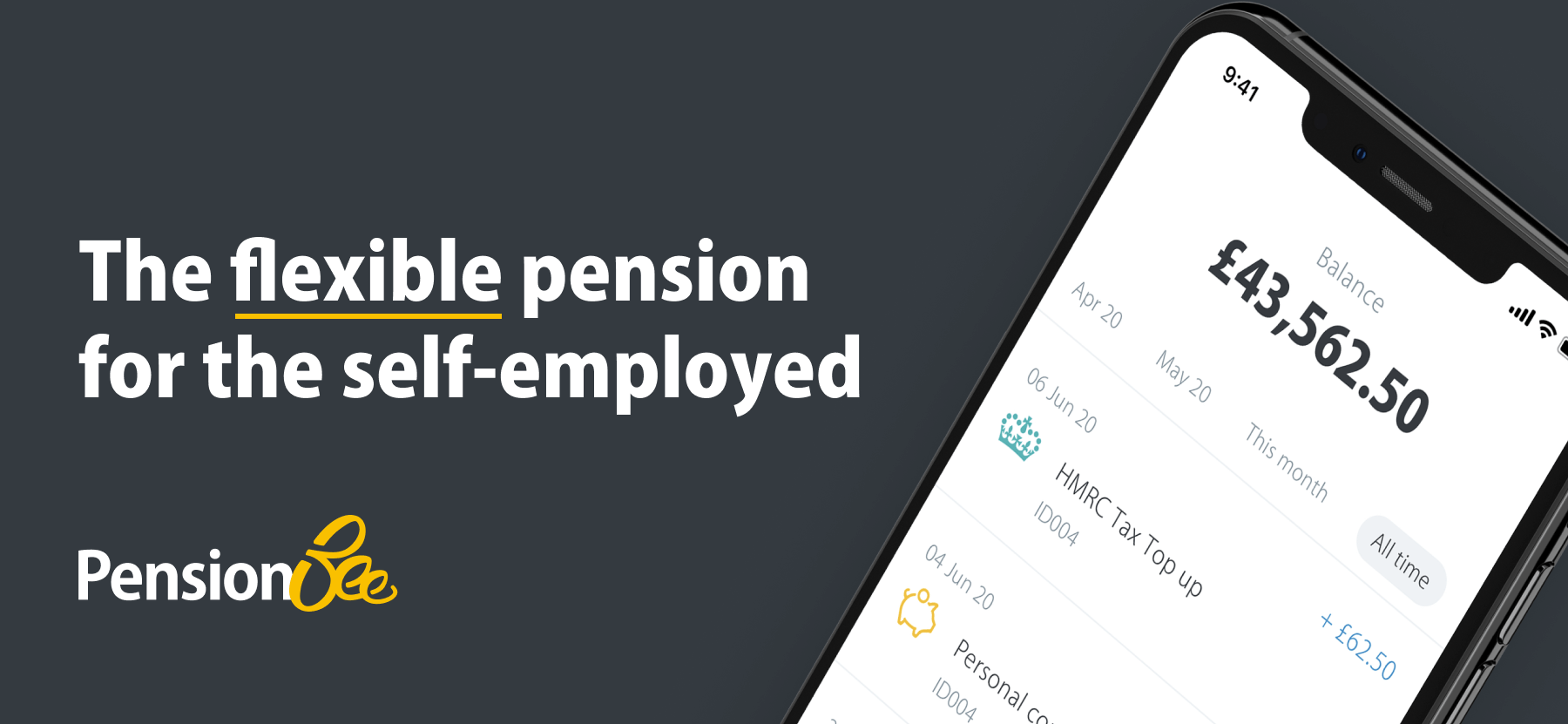This post may contain affiliate links which means that if you click through to a product or service and then buy it, I receive a small commission. There is no additional charge to you.
Important information: The information in this article is not a personal recommendation. If you are unsure about the suitability of an investment based on your individual circumstances, you should speak to an authorised financial adviser. Please also be aware that the value of investments can go down as well as up, and you may get back less than you invest; your capital is at risk.

This is a paid post in collaboration with PensionBee for the launch of their new self-employed pension.

Self-employment is on the rise. However, whilst the number of self-employed workers has grown rapidly over the past two decades, research by the Institute for Fiscal Studies shows that the proportion saving into a private pension has fallen dramatically, from 48% in 1998 to just 16% in 2018.
At the end of 2019 I wrote for the Financial Times about this worrying lack of retirement planning among those who work for themselves. The response from the article was overwhelming; so many self-employed people know that they *should* have a pension set up and be contributing regularly towards their retirement savings, but aren’t. So why is this?
Pension Auto-Enrolment has been a resounding success. Less than half of private sector workers had a pension in 2012, but that figure has now risen to 85%. But auto-enrolment isn’t open to the self-employed. They have to make an intentional decision either to continue paying into a previous employer’s scheme (which often isn’t allowed), or open a private pension.
Being your own boss means you have to be proactive about your own retirement planning. With no HR department sorting out your pension for you or anyone to ask about the best pension for the self-employed, it falls to the individual to do the research, set up a new pension, and initiate ongoing contributions.
Notoriously time-poor, so many fail at the first hurdle. Where to even start? For so long the self-employed population have been underserved by the pensions industry, with a lack of easily accessible and suitable products. They are crying out for a simple and flexible product that they can sign up to easily and without being bamboozled by jargon, so they can concentrate on doing what they do best – running their businesses.
Saving into a pension when your income is variable
As well as the uncertainty around how to set up a pension, the most frequent objection I hear among the self-employed is “My income is variable so I can’t commit a fixed monthly amount to my pension savings”.
Leading online pension provider, PensionBee, has listened to what is needed in the pension industry, and has now launched a flexible pension product for self-employed consumers, enabling them to start a new pension with no minimum contributions.
“Without the benefits of Auto-Enrolment, the self-employed are at a significant disadvantage and need access to simple and flexible products urgently if they are to avoid a shortfall in later life. In the absence of old workplace pensions to provide a head start, we know that the thought of saving from nothing can be daunting for many self-employed consumers, which is why we’ve made it as easy as possible for them to open a pension and put money aside whenever their business allows.”
Romi Savova, CEO of PensionBee
Setting up PensionBee’s self-employed pension
To date, one of the huge advantages of joining PensionBee was that they trace your old employer pensions, transfer them and consolidate old pensions together into one easy to monitor account. Crucially though, you needed to have a previous employer or personal pension to transfer over.
However, in recognition that self-employed people may have never been enrolled into workplace pension schemes, and therefore may not have old pensions to combine, PensionBee is now enabling this group of savers to start a pension from scratch.
From 11 January 2021, those who are self-employed and want to join PensionBee will have the option to start a brand new pension by setting up a contribution as part of their sign up.
PensionBee’s self-employed pension will be available to sign up for free through the PensionBee website, and will soon also be available via the Starling Business Marketplace.
All self-employed savers have to do is provide some personal details and set up a contribution to get started. Once signed up, savers can pay into their pension according to their current income, with no minimum ongoing saving requirements.
I have been a PensionBee customer for a couple of years now. A Direct Debit is set up from my business account to pay monthly into my pension, and I also regularly contribute additional lump sums if I have had a good month. In the past, I have also appreciated the ability to stop contributions all together during the summer months when I take time off and therefore have less money coming in. As someone whose income fluctuates throughout the year, I hugely value the flexibility around contributions which my PensionBee account allows.
Ongoing contributions
PensionBee helps savers manage their pension like they manage their bank account – with 24/7 online access to their balance via the website and app, and the ability to make contributions and withdrawals in a few clicks.
One-off or regular contributions via bank transfer or Direct Debit can be easily set up online or via the PensionBee app.
Contributions can be made from personal or business bank accounts, as a sole trader or a limited company respectively. If you’re the director of a limited company, company contributions may be considered as an allowable business expense and could be offset against your company’s corporation tax. If you fall into this category, do speak to your accountant to make sure you make pension contributions in the most tax efficient way.
What’s the difference between a self-employed pension from PensionBee and a normal pension from PensionBee?
Nothing! There’s no difference to the pension you’ll get; the only difference is in the sign up journey, where you will have the option to skip the “add a pension” step. Everything else remains the same.
New customers can choose from the same choice of pension plans, and enjoy exactly the same benefits as existing customers. PensionBee offers nine investment options, including the new Fossil Fuel Free Plan which completely excludes fossil fuel producers and persistent violators of the UN Global Compact.
See my related post here on why I decided to move my PensionBee savings to the Fossil Fuel Free Plan.

All-in fees range from 0.50% to 0.95%, depending on the plan chosen, with 50% off for the portion of savings over £100,000.
The PensionBee journey
Each PensionBee customer gets their very own UK-based account manager (BeeKeeper) to look after them and their pension <*waves hi to Rosie who is mine*>. In addition, 24/7 online access to their balance is always available via the website and app.
Once they’ve made a contribution, self-employed customers will have access to PensionBee’s bespoke retirement planning tool, designed to help savers better plan for retirement. Here you can see a projection of the retirement income you could end up with based on the size of your current savings and forecast contributions. I’ve found this really useful for motivating me to increase my contributions because I am really going to need more than my current projected annual income!
The myth that the State Pension will support you
If any of you have read this far and are still procrastinating, I think I might know why. There’s a real misconception that people believe they will be able to fall back on the State Pension if they haven’t saved enough ahead of retirement.
So let me ask you this. Do you think you can survive on just over £750 a month?
The full State Pension currently pays an annual income of just £9,110.40, which equates to £759.20 per month or £175.20 per week. If you want to be able to enjoy a comfortable retirement, this will be really difficult without additional savings to top this up. It’s crucial that you start to contribute towards your personal retirement savings now to supplement the State Pension, and allow you to enjoy a higher quality of life in your later years. Your future self will thank you, I promise!

To conclude this article, I want to reflect on an observation I made in that FT article a little over a year ago. I said “At 30 years old, my pension pot was equivalent to my husband’s. Now aged 38, life events mean it is significantly lower, with the gap widening each month. I can never close that gap.”
A little over a year later, that gap continues to widen. He benefits from employer contributions to his pension; as a self-employed person, I do not.
The self-employed don’t benefit from additional ‘free’ money into their pension savings via employer contributions. For this reason they will always face a steeper uphill struggle to save enough for retirement compared to their employed counterparts. This is why it is so important that we take the actions we do have control over to save for retirement; act for the best interest of your future self now and open a personal pension if you haven’t already.

PensionBee CEO Romi Savova joined me in The Money Lounge for a fantastic expert workshop on Pensions 101, where we discussed the importance of retirement planning and what you need to be aware of. For access to this interview and many more expert workshops on topics ranging from Ethical Investing through to Life Insurance plus monthly financial coaching and accountability to achieve your money goals, take a look at our membership community for women, The Money Lounge.

